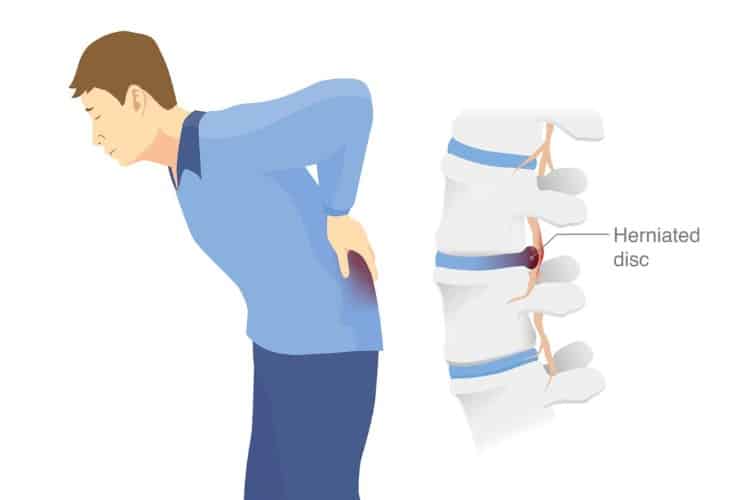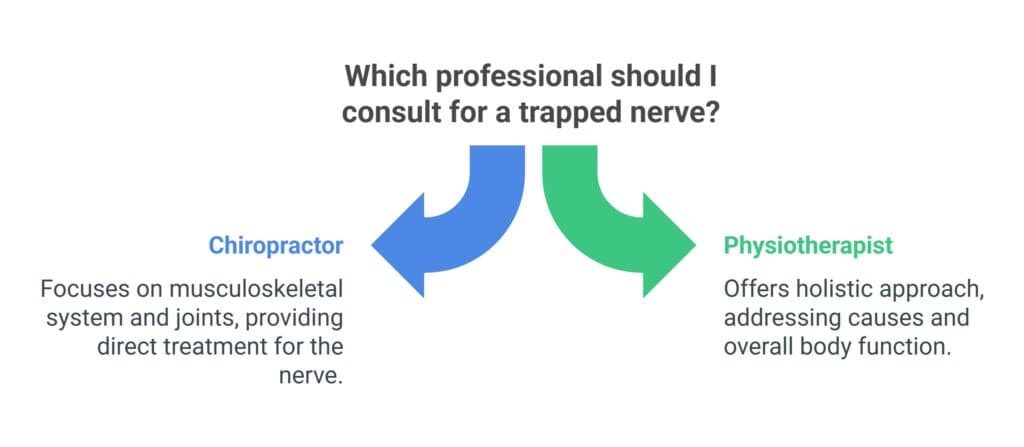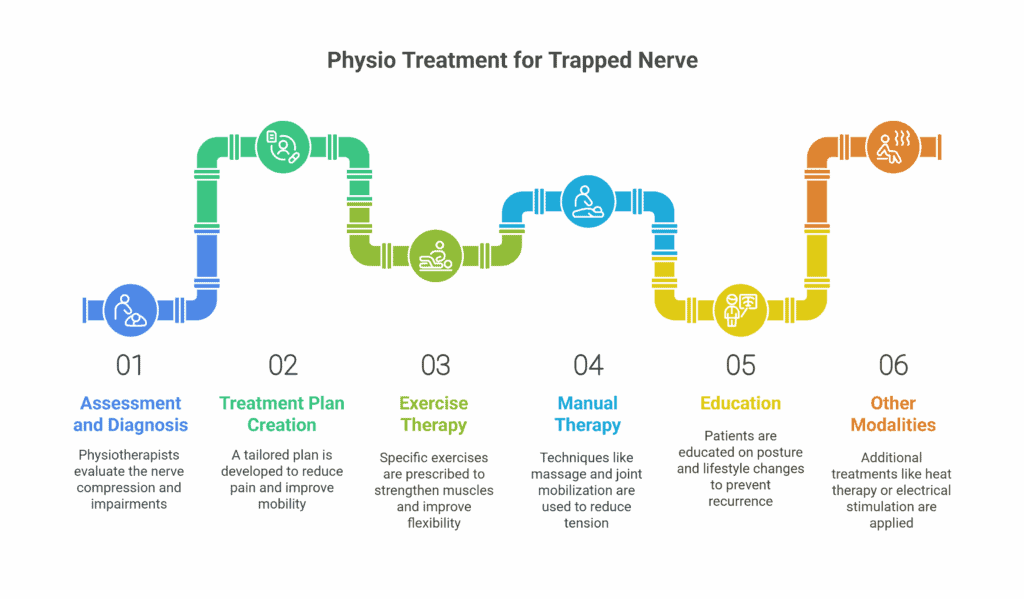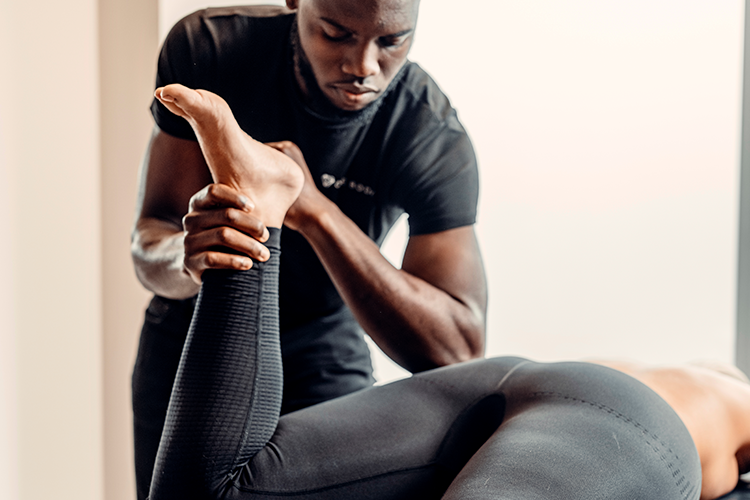Table of Contents
Main Takeaways
- Understanding trapped nerves: Trapped nerves occur when surrounding tissues compress a nerve, often causing pain, numbness, or weakness—typically due to posture, injury, or repetitive movements.
- Physiotherapy offers lasting relief: Physiotherapists assess the source of nerve compression and tailor treatments like exercise therapy, manual therapy, and lifestyle advice to relieve symptoms and restore function.
- Treatment is holistic and personalised: From posture correction and joint mobilisation to acupuncture and traction, physiotherapy addresses both immediate pain and long-term prevention through a whole-body approach.
- Physio vs. chiropractor: Physiotherapists not only treat the trapped nerve but also identify root causes like poor gait or muscle imbalances, offering broader, more preventive care than chiropractors.
- Early diagnosis is key: Prompt evaluation by a physiotherapist ensures accurate diagnosis, distinguishes trapped nerves from conditions like peripheral neuropathy, and initiates effective recovery.
A trapped nerve is no laughing matter – whether it’s causing tingling, numbness, or sharp pains, dealing with a trapped nerve can be both frustrating and debilitating. Many of the patients we see with a trapped nerve find their daily lives are limited by the condition too.
But that’s where physiotherapy steps in. Focusing on restoring normal bodily functioning and easing pain, physiotherapy is the ideal treatment.
In this comprehensive guide, our expert physiotherapists will delve into what a trapped nerve is, the symptoms you might experience, and, most importantly, how physiotherapy can offer relief and aid in your recovery. So, let’s unravel the mysteries of trapped nerves and discover how physiotherapy can help you reclaim your comfort and mobility.
Understanding Trapped Nerves

A trapped nerve, also known as a compressed or pinched nerve, happens when a nerve is pressed or squeezed by surrounding tissues, such as muscles, tendons, or bones. This compression disrupts the normal function of the nerve, leading to a variety of symptoms that can range from mild discomfort to severe pain and, frustratingly, loss of function.
Anatomy-wise, nerves are like electrical cables that transmit signals between your brain and different parts of your body. They consist of nerve fibres bundled together within a protective sheath.
When a nerve becomes trapped, it can happen anywhere along its pathway, but it’s often in areas where nerves pass through narrow spaces or are under a lot of pressure – this could be caused by a herniated disc, for example.
Common areas of the body that experience trapped nerves include:
- Spine: Nerves can become compressed as they exit the spinal column, leading to conditions like sciatica, where the sciatic nerve is affected.
- Joints: Nerves can be compressed as they pass through or around joints, such as the elbow (causing cubital tunnel syndrome) or the wrist (causing carpal tunnel syndrome).
- Muscles: Tight or overused muscles can compress nearby nerves, leading to symptoms like tingling or numbness.
Overuse is a keyword here. At One Body, we see many trapped nerve cases that occur as a result of repetitive motions. This might be typing on a computer or training for a sport – a trapped nerve can impact anyone and everyone, as it’s not about athletic ability but more concerned with repetition and strain.
Other causes of a trapped nerve include poor posture (which usually results in a trapped nerve in the spine), a traumatic injury, and joint conditions. For a practical step-by-step recovery guide, see our how to get rid of a trapped nerve.
Arthritis, for example, can lead to structural changes that compress nerves over time.
Symptoms of a Trapped Nerve
Trapped nerves can come with a variety of symptoms, depending on the location and severity of the nerve compression. Some common symptoms you might be experiencing include:
- Tingling or numbness in the affected area.
- Sharp or shooting pains along the nerve pathway.
- Weakness or loss of muscle function.
- A burning sensation.
- Radiating pain that travels to other parts of the body.
- Sensitivity when you touch the area.
- Muscle spasms or cramps.
You might find that these symptoms get with certain activities or movements. If you suspect you have a trapped nerve, it’s crucial to get an evaluation and treatment from a qualified healthcare professional, such as a physiotherapist. Treatment is key to preventing further complications and promoting recovery!
Peripheral Neuropathy
But what if your nerve pain isn’t caused by a trapped nerve?
While trapped nerves are a common cause of nerve pain, there are other conditions that can create similar symptoms. One of these conditions is peripheral neuropathy, which involves damage to the peripheral nerves outside of the brain and spinal cord.
Unlike trapped nerves, which typically involve compression or irritation at a specific area, peripheral neuropathy often affects multiple nerves. It can impact sensory, motor, and autonomic nerves, leading to a range of symptoms and functional problems.
Peripheral neuropathy may result from an underlying cause, such as diabetes, infections, autoimmune disorders, or exposure to toxins. It can also be idiopathic, meaning the cause is unknown.
Whether you have a trapped nerve or peripheral neuropathy, physiotherapy can help. We start with a diagnosis so you can better understand the cause and status of your nerve conditions, then move onto a treatment plan. To get started, book an appointment in one of our London clinics today.
Physiotherapist vs Chiropractor

You might be wondering if a physio or chiropractor is better for a trapped nerve. You can learn more about the differences between physiotherapists and chiropractors in this guide written by our team, but for now, here’s what you need to know:
- Chiropractors focus on the musculoskeletal system and joints only.
- Physiotherapists specialise in the musculoskeletal system and joints but also take a holistic approach.
So, while both professionals are highly trained and qualified to treat a trapped nerve, the physiotherapist has more expansive knowledge. This means that a chiropractor will have all the tools and knowledge to treat the trapped nerve, but the physiotherapist can do this and help you understand the causes.
We can look at your gait, posture, lifestyle, and strength and ultimately assess your body as a whole to help you regain function.
How Physio Helps a Trapped Nerve

Physio focuses on relieving your symptoms for the short-term, so you can instantly improve your quality of life while also focusing on long-term healing. We start with an assessment and diagnosis.
Our skilled One Body physiotherapists will use various tests and evaluations to pinpoint the location of the compression and assess any impairments in your strength, range of motion, and sensory function.
Next up, we create a treatment plan designed for reducing pain, improving mobility, and restoring function. This will be tailored to your nerve condition and abilities, so don’t worry about trying to do complex activities that are beyond your capabilities even without nerve pain!
The physio treatments we use for a trapped nerve include:
- Exercise therapy – we’ll show you specific exercises designed to strengthen the muscles surrounding the affected nerve, improve your flexibility, and reduce nerve compression.
- Manual therapy – manual manipulations that might involve soft and deep tissue massage and joint mobilisation. This reduces tension and promotes nerve glide.
- Education – we’re here to help you understand your body and the motions that may have caused your trapped nerve, so you can take preventative measures. This might include posture training and lifestyle changes.
- Other modalities – we might recommend other modalities that reduce pain, inflammation and muscle spasms for immediate relief from your symptoms. This might include heat therapy or electrical stimulation, for example.
Traction
Traction is all about elongating the spine or limb that’s impacted by a trapped nerve. Using mechanical traction or manual therapy, your physiotherapist can apply careful tension to stretch the area. This is highly useful for both a trapped nerve and peripheral neuropathy.
By using a stretching technique, we can decompress nerve roots and create space between both joints and spinal vertebrae. As well as instantly providing pain relief, traction can promote healing and stimulate blood flow.
Mobilisation
Mobilisation involves moving the body – it’s that simple.
Joint mobilisation is a hands-on technique used in physiotherapy to gently move the joints through their natural range of motion. During joint mobilisation for a trapped nerve, your physiotherapist applies controlled pressure and rhythmic movements to the affected joint. This is designed to reduce stiffness, improve joint mobility, and reduce the compression on your trapped nerve.
Acupuncture
One last technique that we may recommend for your trapped nerve is acupuncture. This is a complementary therapy that we use alongside manual therapy and exercise.
Acupuncture involves inserting thin needles into specific points on the body to stimulate nerve endings, muscles, and connective tissues. For a trapped nerve, acupuncture can help reduce your pain and inflammation by stimulating the release of endorphins, which are natural pain-relieving chemicals in your body.
Additionally, acupuncture may improve blood flow to the area, encouraging healing and reducing pressure on the trapped nerve.
Trapped Nerve Physiotherapy at One Body

Discover relief for nerve-related discomfort at One Body LDN!
Whether it’s a trapped nerve or peripheral neuropathy, our skilled musculoskeletal physiotherapists offer personalised treatments to soothe your pain and restore function. With comprehensive assessments, thorough treatment plans, and the option to use private health insurance to cover the cost of sessions, there’s no need to endure the discomfort of a trapped nerve any longer.
Book an appointment in one of our London physio clinics today and take the first step towards a pain-free life!
Trapped Nerve Treatment FAQs
Can physiotherapy help neuropathy?
Yes, physiotherapy can help manage the symptoms of neuropathy (including peripheral neuropathy and a trapped nerve) by improving your strength, flexibility, and mobility while addressing underlying causes.
Can physiotherapy help with nerve pain?
Yes, physiotherapy can help reduce nerve pain by using exercise therapy, manual therapy, and modalities to reduce inflammation and improve nerve function. We work on decompressing the nerve for long-term relief too.
How do you release a trapped nerve?
A trapped nerve can be released through various physiotherapy treatments, including exercise therapy to strengthen muscles, manual therapy to mobilise the joint or soft tissues, and modalities such as traction or acupuncture to relieve compression and promote healing.


